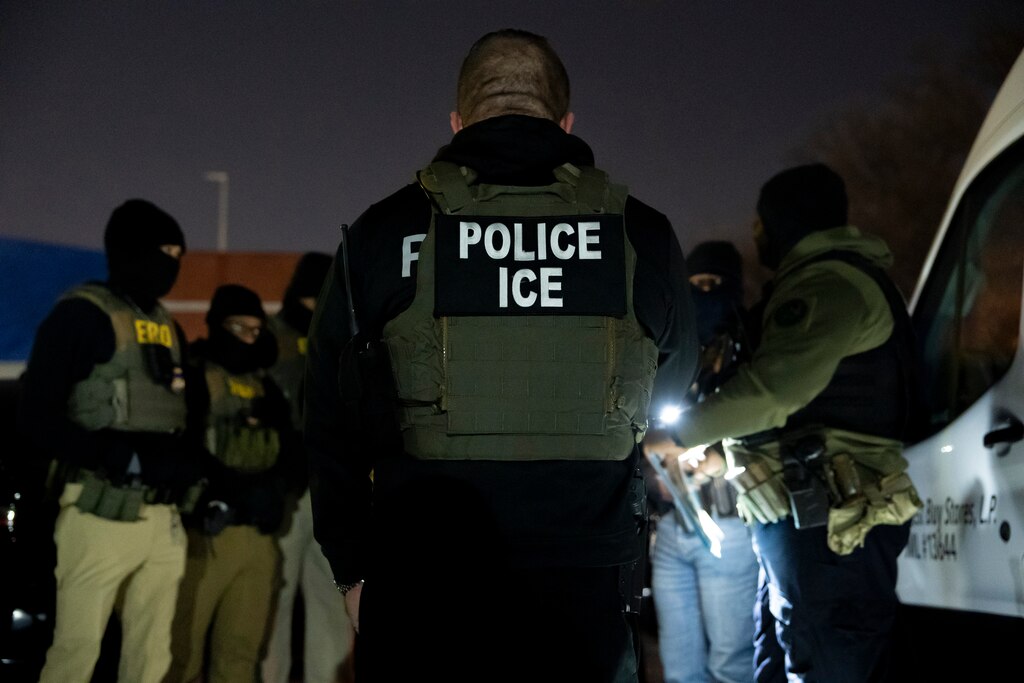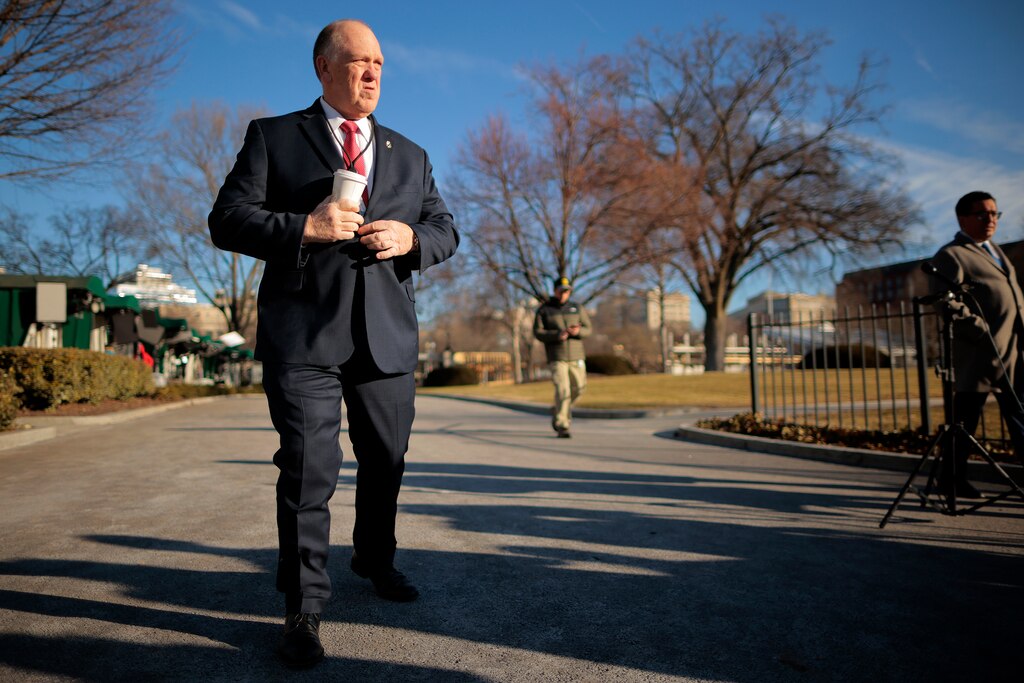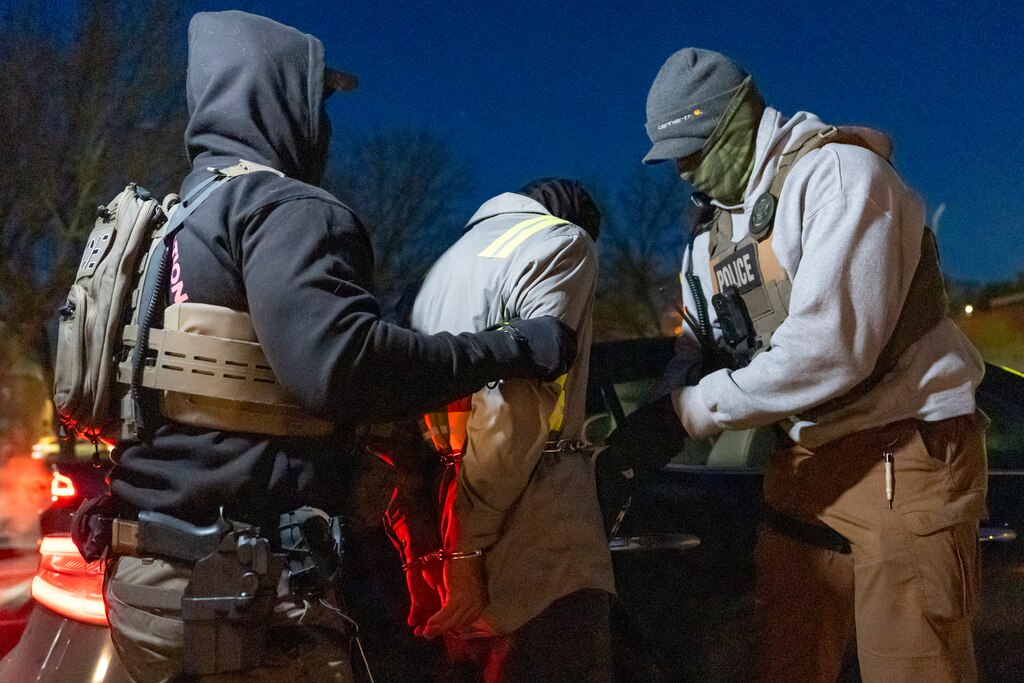U.S. Immigration and Customs Enforcement, commonly known as ICE, operates all over the country, but things look a little different in Maryland. Increasing reports of ICE agents in communities have stoked fear, raising questions about what happens to people who are arrested.
A recent state law restricts the agency, which is part of the massive Department of Homeland Security, from detaining people here, though some local sheriff departments have formal agreements to assist ICE agents with their efforts to enforce immigration law.
Here’s how to make sense of it:
What do ICE agents look like?
Though agents are sometimes seen out in communities wearing branded “ICE” vests and driving around in white vans emblazoned with the Department of Homeland Security emblem, it’s not always easy to identify them.
They can also be out and about in plain clothes, said Valeria Gomez, assistant professor of law at the University of Baltimore, or may strike up a harmless conversation with someone without identifying themselves in order to elicit information. For targeted enforcement actions, they’ll sometimes wait outside a person’s home or workplace.

What happens when ICE arrests someone?
The first stop after an arrest is at a local ICE field office, where officers process a detainee and typically issue a “Notice to Appear” — this serves as a charging document that alleges any immigration violations and will include a date and time when the person is to go before an immigration judge.
Though Trump has moved to expand the use of “expedited removal” — deporting someone before they see an immigration judge — those in ICE custody have the right to present evidence to the government arguing why they shouldn’t be deported. Expedited removal can also apply for someone who a judge has already ordered to be deported, even if the order came in absentia, or without the person present in the courtroom.
After processing, ICE transfers them to a detention facility, either one of their own or a private prison they contract with. Some local attorneys have reported clients being held at the Baltimore field office, located in a downtown federal building, for longer than usual — up to a week at a time. This could be the result of reported overcrowding at ICE facilities nationwide. ICE did not respond to multiple requests for comment.
Some people, often because of certain criminal histories, are subject to mandatory detention, while others can apply for a bond and await their court date at home. That often includes wearing an ankle monitor or reporting to the ICE field office periodically for check-ins.
The recently passed Laken Riley Act modified the Immigration and Nationality Act to expand the use of mandatory detention — it narrows who judges can legally release on bond. Now, mandatory detention is triggered not just by certain criminal convictions, but also by certain charges, including assault or theft. Maryland and federal statutes define some of these crimes differently, creating another wrinkle in how this will play out.
How does ICE conduct its enforcement?
Enforcement priorities have shifted over the years.
The Biden Administration directed ICE to focus on three areas: threats to national security, public safety, and border security, meaning mostly people convicted of violent crimes or those who were caught in the act of crossing the border without authorization. These priorities ebb and flow as administrations change — the Immigration and Nationality Act outlines who can be deported, not who must be deported.

Former Presidents George W. Bush and Barack Obama used similar “prosecutorial discretion” to focus the agency’s resources, both agents on the street making arrests and ICE attorneys prosecuting cases in the courtroom.
Trump’s “border czar” Tom Homan has said that the agency has largely still focused on such priorities, though reports of wider enforcement operations and collateral arrests have been on the rise.
The Trump administration also canceled certain Biden-era programs that allowed people to enter the country temporarily and now groups them with the rest of the undocumented population as eligible for deportation.
Though ICE is limited in staff, detention space and courtroom bandwidth to carry out its mass deportation promise, Trump has moved to bolster capacity by directing other agencies like the DEA to assist with immigration enforcement.
Is it different in Maryland?
Two days after Trump’s second presidential inauguration, Bishop Angel Nuñez received a frantic call about 15 immigrant workers, some of them parishioners, being arrested by ICE in Columbia.
For days, nobody heard from them or could locate them, said Nuñez, the senior pastor at the Bilingual Christian Church of Baltimore, and they are still working to locate them. One possibility, he believes, may be being detained in Central Virginia.
In 2021, Maryland lawmakers passed Dignity Not Detention, which shuttered ICE facilities in the state the following year but, as a state law, cannot prohibit ICE from making arrests here.
The result is that ICE typically sends Maryland resident detainees to out-of-state facilities after processing at the Baltimore field office.
The law has been divisive in communities of immigrant advocates and lawyers. Some advocates said the law was about Maryland taking a moral stance against ICE, but some attorneys have said that it’s made their jobs harder.

Before the law passed, attorney Adam Crandell said he could give his detained clients a clear set of expectations — the same Baltimore judge heard most of the cases of detainees, bond reviews were routine, there was established precedent for what state criminal convictions were deportable offenses in the 4th Circuit.
“All of that went out the window with DND [Dignity Not Detention],” he said.
Many area attorneys said that for years, ICE sent most Maryland residents to a facility in the Moshannon Valley, a remote area of Pennsylvania near State College. The roughly three-hour-plus drive from Baltimore created its own logistical issues for getting documents signed, Crandell said, and worsened the physical separation from family or support networks.
Like many ICE facilities nationwide, Moshannon Valley seems full, though — Crandell said he’s had clients contact him from Buffalo, central Virginia, and Georgia. Each is in a different federal district than Baltimore, he said, meaning different case precedents apply. Crandell said he’s had to prepare himself to argue in all of them.
ICE can also transfer someone to any of its facilities around the country at will.
Since fiscal year 2022, ICE’s Baltimore field office has made fewer arrests than most other field offices nationwide. ICE’s data dashboard only goes back to fiscal year 2021, when the pandemic had completely altered the country.
What changes could be coming?
As the talk of ICE detainees grows, so does the worry about the possibility of reopening facilities and local jails holding ICE detainees.
“I would say there is more enforcement this time. They had four years to game plan this out. [The last Trump presidency] they were more tame,” said Raymond Griffith, a veteran immigration attorney based in Baltimore, who estimates working 14-hour days as a result of more immigration-related work, which includes counseling detained clients.
“I think they have been successful striking fear in people,” he said. “But this is a country of laws, and people have advocates willing to fight for the rule of law.”
Griffith says an uptick in ICE activity is evident by his clients describing being held in a downtown Baltimore ICE facility — which Griffith describes as an “office with bars” on the sixth floor of a federal building — before being sent to a more permanent facility. In the past, his clients might have spent a day there to get processed. Now, they are keeping them there for longer.
“It’s because of the volume of cases and the shortage of beds. It is creating a problem,” Griffith said. ICE did not respond to a request for comment.
Three local sheriff’s offices, in Frederick, Cecil and Harford Counties, have formal agreements with ICE, commonly referred to as 287(g). They will temporarily hold people arrested for a crime and suspected of having violated immigration law so that ICE agents can pick them up. Local lawmakers and advocates have fought tooth and nail to shut dozens of such agreements across the country down.
So far, there have been reports of a mix of targeted ICE arrests for undocumented citizens, with several instances of collateral arrests happening across the country. This includes at least 15 Indigenous people in Arizona and New Mexico being questioned or detained by federal law enforcement searching for undocumented immigrants; to Newark, New Jersey’s mayor claiming ICE agents detained undocumented immigrants as well as U.S. citizens without warrants.
In his first month as a returning president, Trump has signed at least 10 orders and actions related to immigration, including a controversial effort to end birthright citizenship for children of parents who are in the U.S. illegally, which federal judges have blocked. His administration has said it is stepping up use of a U.S. naval base at Guantanamo Bay as a detention facility for 30,000 migrants and will double the number of detention beds under the Biden administration to 100,000.




Comments
Welcome to The Banner's subscriber-only commenting community. Please review our community guidelines.